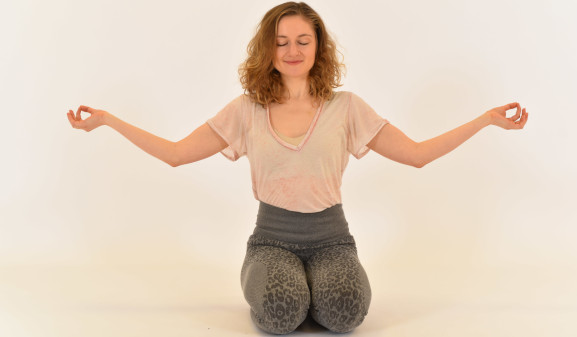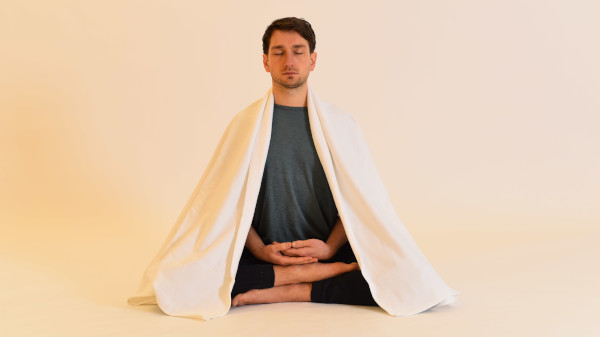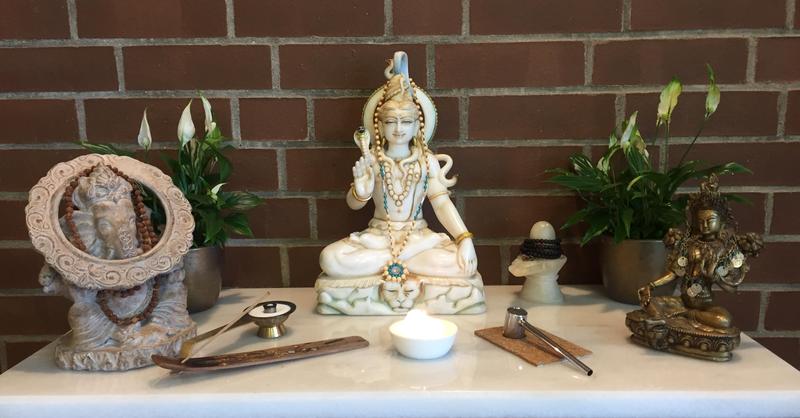Table of contents
- What is meditation?
- Meditation: an experience of peace
- Where to meditate: setting up your practice place
- When and for how long to mediate
- Too busy to meditate?
- How long should you sit for meditate
- Health benefits of a regular meditation practice
- Why Meditate
- How to sit for meditation
- Overcoming obstacle in meditation
- Meditation Exercises
- If your mind is restless in meditation
- Learn more about meditation in one of our seminars
What is meditation?
In general usage, there seems to be much confusion about what meditation actually is, and people use the word to mean a variety of things. Sometimes it is used to mean something that you think about a lot. But, in the yoga tradition, meditation is beyond thinking. Nor do yogis equate meditation with ‘contemplation’ as in many Western spiritual traditions; meditation is seen an experience of Oneness, not an experience of communicating with some divinity.
Many people have the idea that meditation is a sort of blissful mental massage – a relaxing bubble bath for the mind. They are surprised that meditation requires focus, mental exertion, and commitment to a regular practice, but brings an unequalled sense of balance and well-being.
Some yoga students mistakenly refer to the relaxation at the end of class as the ‘final meditation’. However, relaxation is not meditation. When you meditate you are having a universal experience which changes your mind, attitude and awareness which may be likened to the biblical “peace that passeth all understanding”.
Meditation is not relaxing your mind, concentrating your mind, controlling your mind or letting go of stress. These are actually descriptions of ‘how’ to meditate rather than ‘what’ meditation actually is.
Trying to meditate does calm your mind, but this is the step before meditation (dhyana) – yogis call it concentration (dharana). Meditation itself is that experience where your mind is absolutely calm and absolutely peaceful. Many people confuse concentration with meditation. Even most of the scientific studies that claim to be on meditation, actually are about concentration. These studies take a point, have people concentrate on it, and study the effects of the concentration. There is nothing wrong with concentration, but it is not meditation.
Much of this confusion comes from the fact that meditation, like all experiences, cannot really be expressed in words. You understand things in terms of your own experience. This means that you can’t understand anything unless you’ve experienced it yourself.
For example, if you say to a blind friend “that is a really nice blue dress”. Your friend might ask you “What do you mean by ‘blue’?” If I answer, “blue is a cool colour”, does that really explain things properly?
Maybe your friend was born with sight and something happened. Perhaps she was in an accident; maybe she was ill and lost her sight. She might not understand the exact shade but she’ll understand the concept of colour. But if your friend is blind from birth, how will you describe ‘colour’?
How can you understand meditation in terms of your own experience?
Meditation: an experience of peace
For many people, meditation may not be an everyday experience. However, everyone, at some time in his/her life, has probably had some experience of meditation. It is a natural state, a universal experience – or an experience of universality. Most people have had some experience of meditation without even knowing what it is.
Think of a time when you were doing something that you really enjoyed. People have different things that they enjoy. Some people like to listen to music; others love to cook or garden. People who enjoy listening to music can sometimes go on listening for hours; time ceases to exist.
Some people become so engrossed in reading a book that the outside world doesn’t seem to exist for them. They don’t hear the phone ring or feel hungry when it is dinner time. They may sit for hours, even days, without feeling tired. We’ve all heard stories of great painters or musicians who became so inspired that they didn’t sleep or eat for days. We can say this is a low-level mediation, not that it is bad, but there is still duality. When “I am listening to music”, the music is separate from ‘I’.
While you are doing something you really enjoy, the only things that exist are you and the experience. The mind is concentrated. Imagine this experience intensified many times. Imagine your mind becoming so one-pointed that you become that experience. Perhaps this would be a good way to describe meditation.
Meditation is an experience unlike any other. It is an experience of oneness and of ultimate peace. Yogis say that meditation enables you to experience your true nature.
Where to meditate: setting up your practice place
Meditation room / area
You have probably noticed that the ambiance in an airport lacks the inwardly centring energy of a yoga centre or other place where people regularly practice meditation. While it may be true that an experienced meditator can meditate at any time, in any place, for a neophyte a peaceful venue is important and can prove to be extremely helpful in establishing a regular meditation practice.
It is a good idea to create a personal meditation space, either a room or portion of a room that is used only for meditation. If you keep this area free from other vibrations and associations, you will be better able to set up powerful peaceful vibrations. You mind will soon begin to associate this area with a meditation energy that can be helpful when you feel distressed or have a problem. Whenever you sit in this meditation area, you’ll feel comforted by its peaceful vibration.
Be sure that:
- The temperature of your meditation area is at a comfortable level
- The room is well ventilated
- Dim the lights or turn them off completely
- The area should be quiet, with as little outside noise or distractions as possible
Altar/ meditation table
Setting up an altar /meditation table creates a focal point for your meditation practice and opens the door for you to experience a rich inner life. The purpose of the altar/ table is to bring a suggestion of peace when your mind is restless, stimulate positive energy when your mind is sluggish and inspire you to experience deeper states of consciousness. It is an area where you can meditate, pray and express your gratitude.
Begin by dedicating a space. Cleanse the area, first physically – then have a dedication ceremony, invoking positive energy and setting an intention of peace. Some people choose to do a psychic cleansing by waving lights and/or incense – and chanting mantras.
It is best to use a low table, covered with a clean cloth, as your meditation table. Place items on it that elevate your mind; this may include pictures and symbols that you find inspiring. Some people find that deity pictures and/or statues inspire them, whereas other people don’t like them. A picture of a spiritual teacher may remind you of the teachings. It is usually best to not put pictures of family or friends on your meditation table, unless the person is sick or in need of special prayers. You may choose to put a symbol on your altar, such as OM, a Cross, Yin-Yang or a star. Or you may prefer to opt for a simple altar with only a candle and some fresh flowers. Always keep your meditation area clean and pure.
It is best to place your table so that you are facing north or east when you sit in front of it; this can help you to tune into favourable magnetic vibrations. However, this is not a hard and fast rule and may be adapted to your living circumstances.
Place a mat / folded blanket so that you can sit facing your meditation table. It is best to keep this mat only for meditation. You may also like to sit on a cushion. The issue of sitting positions is dealt with separately.
Light on your altar / meditation table
Light is a common symbol of spiritual enlightenment. Place a candle or oil lamp on your meditation table. Some people choose to keep this light burning at all times to enhance the build-up of positive energy in the area, however uou will probably prefer to have the light burning only when you sit for meditation. The act of lighting the lamp sends a suggestion to your mind: “now it is time to be centred and tune to the inner light”.
Incense
Sandalwood and frankincense both have a calming and centring effect on your mind. Indian tradition uses sandalwood; churches use frankincense. Scents such as rose, patchouli or jasmine stimulate your mind. They may smell nice but it is best to not use them for the purpose of meditation.
If you don’t like incense, don’t use it.
When and for how long to meditate
If you lived in tune with nature, the most effective times for meditation would be dawn and dusk when the atmosphere is charged with a special spiritual energy. Sunrise and sunset are the most peaceful times of day.
However, as modern lifestyles often make it difficult to practice meditation at dawn and/or at dusk, it is probably best to choose a time when you are not involved with daily activities and your mind is more apt to be calm. This may be when you first wake up in the morning; your mind is still in a pure state and hasn’t yet become involved with the work of the day. Or perhaps in the evening, when you have put aside the cares of the day, you can use the quiet time to tune inward.
Many people find it convenient to practice meditation in the morning; others prefer to meditate at night. If you calm your mind and purify it by meditation before going to bed, you’ll probably find that you tend to fall into a deep sleep more quickly, rest better and wake up in the morning feeling energised.
Try to meditate at the same time each day. You will gradually come to associate these times with meditation; this will help to facilitate the practice itself.
Before you start, decide how long you will sit for meditation. Be determined that, no matter what, you will sit for this period of time – and then set an alarm. Beginwith twenty to thirty minute periods. Most people find that by meditating for half an hour daily they are able to face life with peace of mind and spiritual strength.
It is a good idea to look at your life and see when you would be most likely to be able to sit undisturbed. Anyone who says “I will try to meditate sometime”, probably won’t. It is best to make a regular time – an appointment with yourself.
Try to not eat for at least two hours before practising meditation. If you plan to practice meditation in the early morning, it is best if your evening meal is light.
Do you think you are busy to meditate?

Often people claim that they want to meditate but don’t have the time. You might remind yourself that if you practise meditation regularly, you will probably work more efficiently and need less sleep.
If you need two hours less sleep per night and feel better after spending half an hour meditating, you are actually gaining an hour and a half of usable time daily. Your mind tends to be centred, calmer and more efficient.
How long should you sit for meditation
Before you begin your practice, give yourself a mental suggestion: “I’m going to sit for half an hour”. It is best to give your mind a time frame. Otherwise after sitting for a few minutes, your mind begins to think of excuses: “Oh, there is a phone-call I have to make”. To counteract this tendency, make the determination that “for the next half hour I am not going to do anything else. Even if I fall asleep, I am not going to get up for half an hour. Make the resolve, and practice every day for the same amount of time.
If, occasionally something happens and you miss your practice, be sure to practice the next day. Don’t put if off; start today; practice daily.
Health benefits of a regular meditation practice
Many people come to meditation seeking relief from ill-health and mental anxieties. As a mind-body modality, meditation has a long history of being used to increase calmness, improve emotional balance and help people cope with illness. Regular practise trains you to channel your thoughts into positive directions.
While meditation, in itself, is not a universal cure, it can help to alleviate pain and reduce the symptoms of many diseases. It positively affects your para-sympathetic nervous system (PNS), which controls heart rate, breathing, and blood pressure. Studies suggest that meditation increases activity in the PNS, causing a reduction in stress, improved blood flow and a healthier supply of digestive juices.
As meditation can help lower your blood pressure, it can prove especially useful if you suffer from any medical condition that is worsened by stress. Getting rid of excess stress is extremely important for the immune system, especially if you are prone to a chronic illness, such as arthritis, diabetes, obesity, or heart and respiratory diseases. Often people with these conditions feel helpless and out of control. Meditation can give you the strength to look at your situation more calmly and with greater objectively.
Apart from the negative consequences of the illness, there is often something positive to be learned from the situation. With regular meditation, you tend to take greater responsibility for your own health You learn to control your prāna (vital energy) and direct it where it is most needed. This creates increasingly favourable conditions for healthy cell regeneration.
Meditation tends to increase activity in the prefrontal cortex, the right anterior insula, and the right hippocampus. These regions of the brain help regulate positive emotions, awareness, and anxiety. When stimulated, these regions support the efficient functioning of the immune system.
If you meditate on a regular basis, you tend to feel more settled, less stressed. Meditation enhances positive thinking, relaxes your body and calms your mind. Increased mental clarity is a frequent side effect of meditation. You begin to develop the ability to understand your current situation, accept it and deal with it efficiently and compassionately. Many people develop greater acceptance of their illness, their thoughts and feelings, and themselves in general.
The peaceful state of mind brought about through meditation encourages non-judgmental observations of emotions, bodily states, and other sensations, leading to greater sense of well-being. Meditation develops mental discipline and willpower and can help you avoid triggers for unwanted impulses. This can assist your recovery from addiction, excessive eating and other unhealthy habits.
Health care professionals are increasingly recommending meditation as part of a multidisciplinary approach to reduce anxiety and chronic pain, and to improve quality of life. Meditation can lead to an improved self-image and more positive outlook on life. Studies show that those who meditate show encouraging changes in attitudes related to positive thinking and optimism.
Recent evidence
Recent evidence supports the use of meditation as an adjunct or complementary therapy to control blood pressure by relaxing the nerve signals that coordinate heart function, tension in blood vessels and the ‘fight-or-flight’ response. Blood pressure decreases not only during meditation, but also over time if you practise regularly. This can reduce strain on the heart and arteries, helping to prevent heart disease.
Meditation-based programmes also seem to be helpful in reducing common menopausal symptoms. They lessen the frequency and intensity of hot flashes, sleep and mood disturbances, and muscle and joint pain.
Irritable bowel syndrome (IBS), post-traumatic stress disorder and fibromyalgia
During meditation, you focus your attention and eliminate the stream of jumbled thoughts that may be crowding your mind and causing stress. Research has shown that meditation seems to improve such symptoms of stress-related conditions as irritable bowel syndrome (IBS), post-traumatic stress disorder and fibromyalgia.
Anxiety
Anxietyis usually about the future; meditation can help you to ground yourself In the present moment. It may also help control job-related anxiety in high-pressure work environments.
Improvements in attention and clarity of thinking are seen as keeping your mind youthful. In addition to fighting normal age-related memory loss, meditation can at least partially improve memory in patients with dementia and increase their mental clarity.
Insomnia
Nearly half the population of Western countries struggle with insomnia at some points in their lives, usually the result of the mind having difficulty quieting down at the end of the day. Studies have found that people who meditate tend to fall asleep sooner and wake up more rested, compared to those who didn't meditate.
Perception of pain
Perception of pain is connected to your state of mind; it can be elevated in stressful conditions. Meditating patients showed increased activity in the brain centres known to control pain and report greater indifference to it. Studies involving patients with terminal diseases found that meditation may also help mitigate chronic pain at the end of life.
Recently, there have increasingly been studies designed to help researchers understand how meditation actually works and how it affects the brain. One interesting finding is that meditation gives the body and mind a more profound rest than does deep sleep. This benefit builds up in the body over time, and reduces stress, which accounts for over 60% of doctor visits.
Meditation isn't a replacement for traditional medical treatment, but it can provide a helpful component.
Why Meditate

Asking “why would I want to meditate?” is like asking “why should I want to be happy?”. We all want to be happy; it’s natural. Ask anyone if they want to be happy, everyone will all say “yes”.
However, if you ask people “What will make you happy?”, you will get many different answers. Each of us has different things that we think will lead to happiness. Most of us spend our lives looking for the thing or the person that will make us happy.
There is a story about a man saw his elderly neighbour in her garden, obviously distraught and looking for something. When he offered to help, the woman told him that she had dropped her glasses inside her house.
Perplexed, the man asked “Why are you looking out here?”
“Oh, it’s dark in my house,” she replied, “so I’m looking out here in sunlight.”
The happiness is within and yet we think “I can’t see it, so let me look outside. Perhaps the bright lights will help me”. As long as anyone thinks that anything outside of herself will make her happy, she will never be really happy and will continue to search for happiness in the wrong places. She might find that she is happy for a short time, but then the happiness wanes and she will seek new pleasures that she hopes will make her happy. Eventually, after searching for many years, perhaps lifetimes, she begins to understand that happiness is within; it is the experience of peace. If you have inner peace then you are basically a happy person. A happy person can have many things or nothing at all. Without inner peace no one will be happy, however many things he has.
As we all want to be happy, let’s begin to look in the right place. Meditation is the experience of happiness and inner peace. With practice, meditation makes it possible to see what life is really about, what really makes one happy. It gives the tools to change things rather than merely wishing they were different. Before attaining ‘higher’ states, these simple techniques cultivate stability, strength, clarity and openness.
Learning to meditate is a priority for anyone wanting to lead a happy, centred life. Meditation works on the deepest levels, bringing about profound physical, psychological, emotional, intellectual and spiritual changes. It works on many levels simultaneously and changes the practitioner’s outlook on life. The process of learning to meditate helps you to develop skills that enable you to deal with life in a balanced, open-hearted way.
How to sit for meditation

Leg positions
If you want to facilitate inward focus, begin by bringing your body into a position that will prevent your energy from “leaking”. This is the reason that yogis prefer to sit in a cross-legged position; this pose physically contains your energy. Your legs form a type of infinity symbol. There is no need to sit in a classical padmasana (lotus pose); even a simple cross-legged position is very stable, grounding.
Anyone who is unable to sit cross-legged with their back straight should put a cushion or a rolled up blanket under their buttocks. However, make sure that they don’t sit up too high, otherwise their back will arch.
For those unable to comfortably sit cross-legged, kneeling (as in Zen meditation) is an alternative. Sitting in a straight backed chair is a third alternative. Chairs are suggested only for people with severe physical problems or elderly people who cannot sit on the floor. In this position, you need to keep your feet flat on the floor and not cross your ankles.
Whichever position is preferred, it is most important that it is a stable, balanced and grounded position that can be held. Remember that every time your body moves, your mind moves. To quiet your mind, begin by quieting your body.
Posture strongly affects the state of your mind. If you slump forward, you will tend to fall asleep. Alternatively, if you sit up too straight and rigid, you create tension in your body.
Back and head
It is important to keep your back straight so your energy can travel up your spine and your breath can be full. When your back is bent, the movements of your diaphragm and ribcage are blocked. It is difficult to breathe. When you can’t take a full deep breath, there is the tendency to fall asleep. This is especially true in the morning your mind is still in a sleepy state. It is best to sit straight and take deep breaths; making sure that a liberal supply of oxygen reaches your brain. Many people find it helpful to imagine a fine thread pulling their heads up – and another thread attached to the top of their breastbone, keeping their chests upright.
Mudra – hand positions
The word ‘mudra’ literally means seal. Mudras seal in the prana into certain channels; they can send a signal to your mind that it is time to enter a meditative state.
In ‘chin mudra’ the classical yoga hand position for meditation, the tips of your thumb and forefinger are joined and you rest the backs of your hands on your respective knees. Some people prefer to bring their hands together.
Please consult the articles about ‘mudras’ for more information on this topic.
Overcoming obstacle in meditation
1. Be in the Moment
Memories of the past and daydreams can often distract your mind when you are trying to meditate. If these come up, just bring your mind back to your point of focus – whether it is your breath, a mantra, a visualization, or whatever other technique you have chosen to use.
2. Avoid Fault-Finding and Replaying Thoughts
Try not to review the shortcomings of other people when you are sitting for meditation and also be careful not to get caught up in self-criticism. If you find your mind re-processing the events of the day, remind yourself to come back to your point of focus.
3. Muscle Cramps
You could take a walk before sitting to prevent cramps. Make sure that you are getting enough potassium in your diet- and maintaining a healthy potassium-magnesium-calcium, balance. Consider eating more bananas, dried apricots, prunes and other fruits.
4. Let Go of Anger
You may experience anger and/or other emotions when you try to focus your mind. Try visualizing the emotion as a bubble that grows, but then pops, releasing the emotion. Anger and irritability can be overcome by developing the counter-attitude of patience. Regular meditation will also help eliminate the causes of anger, slowly changing your perspectives.
5. Be Aware of Your Eating Habits
You might find it interesting to monitor both the quality and the quantity of your food intake – and its effect on your meditation. Some foods, such as wheat products and other carbohydrates, can leave you feeling heavy, bloated and sleepy. Other foods, such as fruits and raw or lightly cooked vegetables digest more quickly and nourish you without draining your energy. Practising after a meal encourages drowsiness, so make sure to leave at least a two-hour gap between eating and meditating. Try to make your diet as pure and nourishing as possible; you can read more about a yogic diet: www.yoga-vidya.org/english/yoga-articles/diet/
6. Be Fearless
You may uncover hidden fears during meditation that have been lurking within your subconscious mind. These can manifest in many forms: fear of death, disease, solitude, criticism, or even just facing yourself. All fear stands in the way of meditative progress, so develop the habit of observing them with detachment. You will find that many will dissipate of their own accord if, instead of allowing yourself to get caught up with them, you simply return your attention to your chosen point of meditation focus.
7. Keep Going
Many people try to do too much too quickly and find themselves so overwhelmed that they stop their practice completely. The most important thing is to carry on. Try adopting the yoga concepts of vairagya (detachment; non-expectation of immediate benefits) and abhyasa (steady, regular practice).
Meditation Exercises

Meditation Exercise 1: Using your breath to calm your mind
Your breath, your most intimate companion, is with you throughout your life. It is the mediator between your body and your mind, responding instantly to your emotions and thoughts.
When you sit to meditate, one very common and extremely helpful technique is to use your breath as your point of focus. This has a number of benefits, as your mind and breath are so closely connected.
Sit in your chosen meditation position. Be sure that your back is straight. Rest your hands on the respective knees with your palms upwards; join the tip of your thumb with the tip of the index finger on each hand (chin mudra).
Close your eyes and take a few deep breaths. Then let your breath come into whatever rhythm and depth feels comfortable. Don’t try to control your breath. Notice how it rises and falls. Do not try to change or slow your breath, but just watch it. Be a silent observer.
Watch each part of your breath. See how it enters your nostrils; feel it moving past the back of your throat, down your trachea into the bronchi, entering your lungs and filling the air sacs.
Feel your breath halt for a moment. Then your inward-moving breath turns around and becomes the out-breath. Watch the breath leaving your lungs, moving up past your throat, and out of your nostrils. Feel a bit of wind on your upper lip. Then notice how your breath stops for a moment, turns around – and the out-breath becomes the in-breath again.
Joyously draw in life with each inhalation.
Release pent up emotions and impurities with each exhalation.
Feel the movement of your breath in your abdomen. Don’t try to “breathe”. Instead, allow the breath to happen. Allow the breath to breathe your body. Focus your mind and all of your senses on your breath.
If your mind drifts off, bring it back to your breath. Your breath is your most natural focal point. As many times as your breath wanders, keep bringing it back to focus on your breath. With a bit of practice, your mind will come to this point automatically.
As your mind focuses on this point, cares and worries drop away.
Try to sit for at least 20-30 minutes daily, keeping your mind completely focused on your breath.
Meditation Exercise 2: Listening to the sound of your breath
Sit in a comfortable meditation position, preferably cross-legged. Rest your hands on your thighs. Give yourself the mental suggestion that you will sit still and be fully focused for the next 20-30 minutes. Try not to move a single muscle, or your mind will be drawn outward.
Close your eyes and bring your awareness to the back of your throat. Take 3-4 deep breaths and then stop trying to control your breath, instead concentrate on listening to its natural sound. Let your breath come to a natural rhythm, as slow or as fast as it wants to be. You are not controlling it, only listening.
As you inhale, hear your breath making the sound “SO”. Feel yourself joyously drawing in life.
As you exhale, hear your breath will naturally repeat the mantra of the throat chakra, which is “HAM”. Don’t try to repeat the mantras, but listen to your breath as it naturally says them. Let go of pent up tensions and aggressions. Let go of expectations. Be still and be open to the experience. Gradually your mind will calm.
If your mind drifts off, keep bringing it back to the sound of your breath.
Try to sit for at least 20-30 minutes daily, keeping your mind completely focused on the sound of your breath.
If your mind is restless in meditation

Emotions and repressed feelings often surface when you begin to meditate. These are best dealt by locating where in your physical body you feel them. For example, do you experience your boredom/ frustration/ anger in your chest, your shoulders, your neck...? Once you’ve tuned into and located the feeling, you can observe it, breathe into it, visualize the release of a bit of the feeling with each out-breath, and then just gently return your mind to your original point of focus.
Here are some of the most common mental distractions that meditators tend to experience, including suggestions of how to manage them:
Replaying thoughts: Unfortunately, certain thoughts can be like tunes that continue to replay in your mind, so if you aren’t vigilant when such thoughts pop into your mind during meditation, you may find yourself pursuing them and their associations. Whenever you realize that you’ve gotten side-tracked in this way, just gently bring your mind back to your point of meditation focus.
Cravings and desires: Your sub-conscious mind contains numerous desires that can come to the surface when you sit for meditation. If you’re not careful, these can spawn endless chains of thoughts that you risk getting caught up in. The best course of action is to neither try to actively suppress desires or cravings, nor allow yourself to engage fully with them. The best way to starve them of attention is by keeping your mind anchored on your chosen meditation focus, and gently bringing your awareness back to this focus if ever it drifts.
Ceaseless wandering of the mind: In the absence of external distractions, your mind is likely to amplify its attempts to entertain itself by “wandering” off and thinking of other things. Just gently return your focus to its original point each time you notice it straying. With practice, your mind will wander less, until eventually it enables you to achieve deeper levels of insight.
A sense of boredom: throughout your waking day you probably spend most of your time in a state of “doing”, with your mind making sure that you’re busy all the time, in a constant state of stimulation. During meditation, when you are in a state of “being”, your mind may therefore perceive sitting quietly and focusing on just one thing as “boring” or disengaging – and choose to rebel against it to try to get attention.
It’s important to realize, however, that any sense of “boredom” is just a trick of the mind that occurs when the subject at hand is being skimmed over rather than focused on, as a truly concentrated mind is never bored. So if you do experience a sense of boredom while meditating, ask yourself whether you are actually bored with your practice – or maybe with something else? For example, perhaps you are bored with your job or with the current pattern of your life in general? With regular practice, meditation can help to relieve such boredom.
As the tendency of the mind is to identify with thoughts, feelings and emotions, the longer you allow yourself to think ‘I am bored’, the more difficult it will be to rid yourself of it. It is therefore best to try to just witness the feeling and detach from it, rather than giving it fuel! You might want to focus on the breath instead - ‘breathing out’ the boredom and ‘breathing in’ a sense of peace
Conditions of participation
Yoga Vidya is a non-profit association and Europe's leading provider of education and training in yoga, meditation, Ayurveda, massage, holistic health and spirituality.




